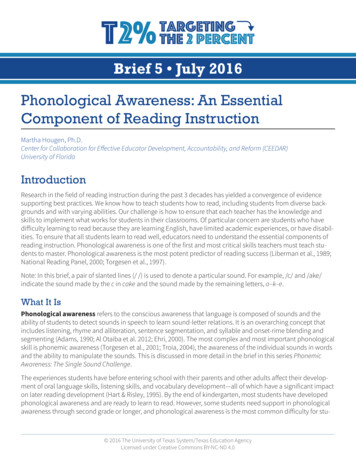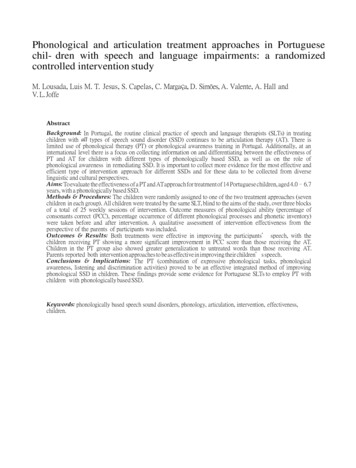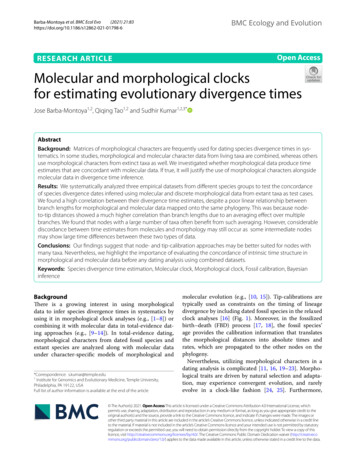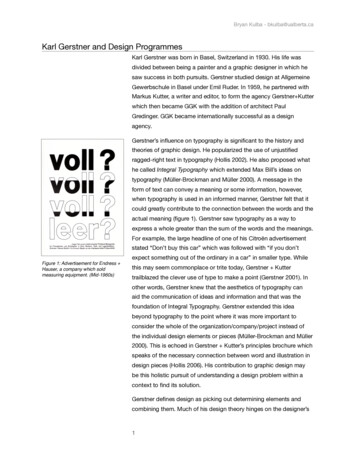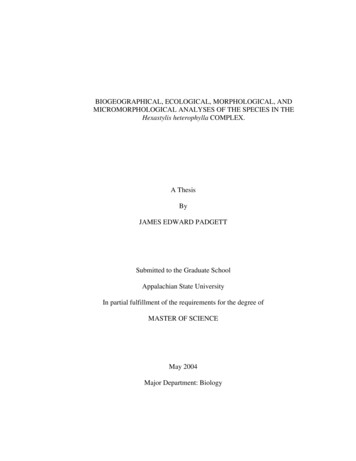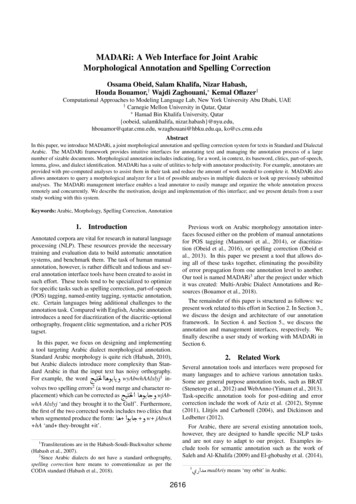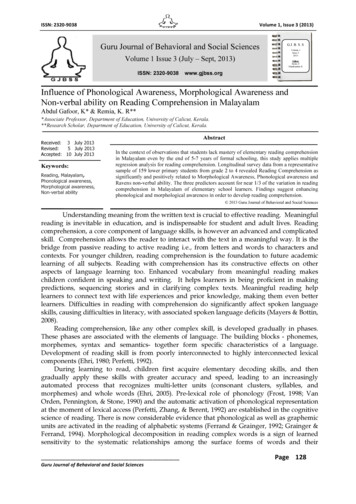
Transcription
ISSN: 2320-9038Volume 1, Issue 3 (2013)Guru Journal of Behavioral and Social SciencesG.J. B. S. SVolume 1Issue 32013Volume 1 Issue 3 (July – Sept, 2013)ISSN: 2320-9038EditorJayan, CManikandan Kwww.gjbss.orgInfluence of Phonological Awareness, Morphological Awareness andNon-verbal ability on Reading Comprehension in MalayalamAbdul Gafoor, K* & Remia, K. R***Associate Professor, Department of Education, University of Calicut, Kerala.**Research Scholar, Department of Education, University of Calicut, Kerala.Received: 3 July 2013Revised:5 July 2013Accepted: 10 July 2013Keywords:Reading, Malayalam,Phonological awareness,Morphological awareness,Non-verbal abilityAbstractIn the context of observations that students lack mastery of elementary reading comprehensionin Malayalam even by the end of 5-7 years of formal schooling, this study applies multipleregression analysis for reading comprehension. Longitudinal survey data from a representativesample of 159 lower primary students from grade 2 to 4 revealed Reading Comprehension assignificantly and positively related to Morphological Awareness, Phonological awareness andRavens non-verbal ability. The three predictors account for near 1/3 of the variation in readingcomprehension in Malayalam of elementary school learners. Findings suggest enhancingphonological and morphological awareness in order to develop reading comprehension. 2013 Guru Journal of Behavioral and Social SciencesUnderstanding meaning from the written text is crucial to effective reading. Meaningfulreading is inevitable in education, and is indispensable for student and adult lives. Readingcomprehension, a core component of language skills, is however an advanced and complicatedskill. Comprehension allows the reader to interact with the text in a meaningful way. It is thebridge from passive reading to active reading i.e., from letters and words to characters andcontexts. For younger children, reading comprehension is the foundation to future academiclearning of all subjects. Reading with comprehension has its constructive effects on otheraspects of language learning too. Enhanced vocabulary from meaningful reading makeschildren confident in speaking and writing. It helps learners in being proficient in makingpredictions, sequencing stories and in clarifying complex texts. Meaningful reading helplearners to connect text with life experiences and prior knowledge, making them even betterlearners. Difficulties in reading with comprehension do significantly affect spoken languageskills, causing difficulties in literacy, with associated spoken language deficits (Mayers & Bottin,2008).Reading comprehension, like any other complex skill, is developed gradually in phases.These phases are associated with the elements of language. The building blocks - phonemes,morphemes, syntax and semantics- together form specific characteristics of a language.Development of reading skill is from poorly interconnected to highly interconnected lexicalcomponents (Ehri, 1980; Perfetti, 1992).During learning to read, children first acquire elementary decoding skills, and thengradually apply these skills with greater accuracy and speed, leading to an increasinglyautomated process that recognizes multi-letter units (consonant clusters, syllables, andmorphemes) and whole words (Ehri, 2005). Pre-lexical role of phonology (Frost, 1998; VanOrden, Pennington, & Stone, 1990) and the automatic activation of phonological representationat the moment of lexical access (Perfetti, Zhang, & Berent, 1992) are established in the cognitivescience of reading. There is now considerable evidence that phonological as well as graphemicunits are activated in the reading of alphabetic systems (Ferrand & Grainger, 1992; Grainger &Ferrand, 1994). Morphological decomposition in reading complex words is a sign of learnedsensitivity to the systematic relationships among the surface forms of words and theirGuru Journal of Behavioral and Social SciencesPage 128
ISSN: 2320-9038Volume 1, Issue 3 (2013)meanings. Thus, phonological awareness and morphological awareness are likely to join ininfluencing the level of language abilities including complex ones like reading comprehension.Need of the studyA sizeable proportion of students have a low level reading comprehension. Based on theobservation that nearly half the pupils in upper primary school have difficulty in interpolatingor extrapolating a simple passage, a study from Kerala (Gafoor & Kaleeludeen, 2008) hasconcluded that students at this stage of schooling lack mastery of elementary readingcomprehension in Malayalam. A more detailed analysis (Gafoor, 2011) revealed that theelementary reading comprehension is not up to the level expected of Grade 3 students amongaround half the students in Grade 5, though it slightly improves in the next two grades.Comparing this observation with previous ones, the study revealed that comprehension andderiving conclusions, which are especially being focused in the present primary schoolcurriculum with its leanings towards constructivist, critical pedagogy and issue-basedapproaches, have not enhanced after the educational reforms in Kerala during the first decadeof 21st century. Hence, further progress in elementary education, among other things, calls forgreater reliance on scientific evidence to guide educational policies for assessment andinstruction on factors that contribute to early reading development.Four focal variables involved in reading development are phonological awareness,naming speed, orthographic knowledge, and morphological awareness (Roman, Kirby, Parrila,Wade-Woolley, & Deacon, 2009). Morphological awareness between grade 3 and 5 affectedreading comprehension (Kirby, Geier, & Deacon, 2009) and hence is associated with readingabilities in later elementary school. A quick review of literature demonstrated that studies onmorphological and phonological awareness and their impact on language outcomes inpreprimary and elementary grades are numerous in languages like English (Griva &Anastasiou, 2009), Chinese (Perfetti, et al. 1992), Arabic (Abu-Rabia & Abu-Rahmoun,2012 ),and the same is not rare in French (Deacon & Wade-Wolley, 2005), Spanish (Dickinson,McCabe, Clark-Chiarelli, & Wolf, 2004), Korean, Iranian (Ghaemi, 2009), Finnish (Puolakanaho,2007) and Japanese. However, studies on these variables in Indian languages, includingMalayalam was hard to find.Relevance of phonological and morphological awareness and non-verbal ability for readingPhoneme is the smallest distinctive unit of sound system of a language. Phonology, thestudy of sound system of languages, is concerned with how sounds function in relation to eachother in a language. Each language has its own phonological system. For instance, EnglishReceived Pronunciation has 44 distinctive sounds while standard Malayalam has a system of 52(Syamala, 1996). Phonological awareness refers to the awareness of phonological structure orsound structure of spoken words in a given language.In order to read the words in print, children must understand that speech is comprisedof sound segments at the level of phonemes (Blachman, 1994; Liberman, Shankweiler, &Liberman, 1989; Yopp & Yopp, 2000). Studies demonstrate strong and specific relationshipbetween phonological awareness and early acquisition of reading (Adams, 1990; Bradley &Bryant, 1983; Bryant, MacLean & Bradley, 1990; Goswami & Bryant, 1990; Stanovich, 1992;Wagner & Torgesen, 1987). Phonological awareness promotes children’s understanding of therelationship between speech and alphabetic orthography.Children who have better abilities in analyzing and manipulating rhymes, syllables,and phonemes are better at learning to read than children who have difficulties in acquiringthese skills. The relationship between phonological awareness and early reading acquisition ispresent even after such factors as intelligence, vocabulary skills, and listening comprehensionare partialled out (Bryant, MacLean, Bradley & Crossland, 1990; Stanovich, 1992; Wagner &Torgesen, 1987). Phonological awareness has a unique relation with word reading (Lonigan,Anthony, Philips, Purpura, Wilson, & McQueen, 2009). Further, phonological awarenessenables children to produce possible words in context from the partially sounded out words byGuru Journal of Behavioral and Social SciencesPage 129
ISSN: 2320-9038Volume 1, Issue 3 (2013)elaborating similar phonemes in words. Indeed, children who are quick to develop the ability toanalyze and to construct a connection between sound segments and letters almost invariablybecome better readers than children who have difficulties in developing these early skills (Share& Stanovich, 1995). A substantial positive correlation was found between the early phonologicalawareness and reading acquisition in kindergarten children in Hebrew. Phonologicalawareness had significant association with hearing children (Kyle & Harris 2006). Recentresearches evidence not only that reading skills and phonological awareness are associated(Gray & McCutchen, 2006) but also that difficulties in phonological processing directly disturbthe semantic process involved in comprehension. For instance, children with literacy disabilitiespresented deficits in phonological processing and language (Barbosa, Miranda, Santos, &Bueno, 2009).Morphemes are the minimum meaningful units of a language. Study of structure ofwords, of how morphemes are put together or organized to form words, is called morphologyor morphemics. Identification, analysis and description of the structure of morphemes are thetasks of morphology. Morphological awareness, a higher order cognitive ability, involves beingconscious of and the ability to manipulate the morphological units. It involves the ability toidentify root words and their inflected or derived forms. It is the ability to segment words intomeaningful units and to manipulate morphemes to create new meanings, that is, to understandthe structure of a word, its meaning, and the different combinations of its morphemes. Thus,morphological awareness refers to a conscious awareness of word structure and semantic–functional meanings while taking into consideration the root, structure, base form, and suffixesrepresenting inflectional and derivational processes (Kieffer & Lesaux, 2008).Stothard, Snowling, Bishop, Chipchase, and Kaplan (1998) provided further evidencelinking spoken language issues with reading outcome. In a follow-up study of adolescents whowere identified with specific language impairment (SLI) in preschool, Stothard and colleaguesdiscovered that, when tested at age 15, those participants who had early diagnosis of SLIpresented with later difficulties in word reading accuracy, reading comprehension and spelling.Moreover, intervention studies revealed that morphological awareness training has a positiveeffect on language processing in speech and reading (Elbro & Arnbak, 1996), including nonspecific beneficial effects on word reading (Ghaemi, 2009).It is clear that morphology plays a role in reading acquisition. Morphological awarenessis in fact related to children’s reading comprehension (Carlisle, 1995; 2000; Singson, Mahony &Mann, 2000; Kuo & Anderson, 2006; Nagy et al., 2006), especially in elementary grades (Carlisle& Fleming, 2003). Young readers are sensitive to the morphemic structure of written words(Casalis, Dusautoir, & Cole, 2009). And, normal readers’ morphological awareness is crucial inpredicting reading their comprehension (Siegel, 2008); and morphological awareness actuallycontributes to reading comprehension (Casalis & Louis-Alexandre, 2000; Kuo & Anderson,2006; Nagy et al., 2006). This contribution increases with age as children are exposed toincreasingly higher-level texts comprising unfamiliar everyday words (Kuo & Anderson, 2006).The importance of morphological knowledge for reading increases over the school years, sideby side with children’s growth in literate lexicon (Carlisle, 2000; Shankweiler et al., 1995;Singson et al., 2000). Indeed, morphological awareness in kindergarten was found to predictreading comprehension in the first three years of elementary school (Carlisle, 1995; Casalis &Louis-Alexandre, 2000). Morphological awareness contributed significantly to the explainedvariance in reading comprehension in both English and Chinese for second, fourth, and sixthgraders (Kuo & Anderson, 2006). The contribution of morphological awareness to readingcomprehension was higher for fifth graders than for third graders (Signson, Mahony, & Mann,2000). Reading comprehension may be a matter of general language understanding and not aunique feature of reading (Rayner, Foorman, Perfetti, Pesetsky, & Seidenberg, 2001). However,this applies more for adult and more fluent readers, than for those who learn to read.Guru Journal of Behavioral and Social SciencesPage 130
ISSN: 2320-9038Volume 1, Issue 3 (2013)While there can be relation between phonological and morphological awareness amonglearners, studies demonstrated that morphological awareness contributes to readingcomprehension independently of phonological abilities (Deacon & Kirby, 2004; Nagy et al.,2006; Singson et al., 2000) and even beyond the contribution of phonological awareness (Casalis& Louis-Alexandre, 2000; Deacon & Kirby, 2004; Singson et al., 2000). Morphological awarenessin normally reading fourth through ninth graders contributed a unique explanation of thevariance in reading comprehension, beyond phonological abilities (Nagy et al., 2006).Morphological awareness develops throughout children’s time in school (Nagy,Diakidoy, & Anderson, 1993). Children at the age of three could create compound words toindicate meaning (Clark, 1995). Preschool children were able to begin to identify morphemes,including both inflections and derivations (Carlisle, 2003). In addition, third graders’knowledge of derived words increases sharply (Anglin, Miller, & Wakefield, 1993). Nagy et al.(1993) also suggested that as the morphological complexity of text continues to increase,different aspects of morphological awareness would grow through high school. As a result, itmight be expected that the predictive role of morphological awareness in readingcomprehension would also increase with age (Nagy et al., 2006). Morphological awarenessaffected reading comprehension directly. It is explained that morphological or syntacticawareness leads to increased breadth and depth of word knowledge, which in turn affectsreading comprehension (Guo, Ying, Roehrig, Alysia, & Williams, 2011).Intelligence is the best-documented predictor of achievement of literacy and otheracademic outcomes (Gottfredson, 1997; Hartigan & Wigdor, 1989). At the age of 10, intelligenceexplained an additional proportion of the variance in literacy skills (Alloway & Alloway, 2010).Though IQ plays important role in predicting reading comprehension (Tiu, Thompson, &Lewis, 2003), there are few studies on the relation of reading comprehension and intelligence.While verbal IQ predicted reading comprehension (Berninger, Abbott, Vermeuleu, & Fulton,2006), nonverbal IQ is related to reading outcomes in children with language impairment(Catts, Fey, Tomblin & Zhang, 2002); in fact, nonverbal intelligence at kindergarten was thethird strongest predictor of reading comprehension at second grade and the second strongestpredictor of reading comprehension at fourth grade. While few studies connect readingcomprehension and intelligence, at least one study, explored the influence of morphologicalskills on reading comprehension by controlling Ravens progressive intelligence (Mahfoudhi,Elbeheri, Al-Rashidi, & Everatt, 2010).MethodThis study investigates reading comprehension using phonological awareness,morphological awareness and non-verbal ability as the predictor variables. Longitudinal surveydesign is used in data collection (group and individual tests), as measure of readingcomprehension was delayed for two years after the measures of predictor variables in grade 2.ParticipantsSample used for this study constitute lower primary students in Grade 2 to 4 from 11Lower Primary Schools of Thrissur district in Kerala (N 159). The sample was representative ofthe population on sex ratio and type of school management.Instruments1. Test of Phonological Awareness: This individually administered test designed for LowerPrimary students has three subtests, viz., picture-sound recognition, rhyme recognitionand rhyme production. Picture-sound recognition test constitutes 45 colour pictures ofobjects familiar to children whose names correspond to 47 phonemes identified fromsyllabus for grade 1. Oral instruction was given to the students during administration.When the test administrator presents four pictures at a time and pronounces aGuru Journal of Behavioral and Social SciencesPage 131
ISSN: 2320-9038Volume 1, Issue 3 (2013)sound/phoneme, the child has to find the picture corresponding to the pronouncedsound.Rhyme recognition test has prompt pictures rhyming with one of the targetpictures. Choosing the rhyming target picture is the task. The test consists of twopractice items and five test items. Rhyme production test has prompt words for whichrespondent has to produce rhyming words or pseudo words. The whole test takes 20minutes to administer per child. Test validity is indicated in loading of all the subtestson a single factor with loading ranging from .78 to .74.2. Test of Morphological Awareness: This individual test meant for 2nd graders has eightcategories of morphemes viz., gender, number, case, compound word, derived word,derived adjective, tense and kevalaprayojaka. Each has two practice items and followingnumber of test items. For each subtest, oral instruction is given by the investigator as towhat is expected from the student, a pause of 10-15 seconds were given for the studentto respond with the answer for each item. The whole test takes 20 minutes to administerper child.3. Test of Reading Comprehension:This is a subtest of the reading test (Gafoor &Khaleeludheen, 2008) for 4th grade students consisting of five passages with selectiontype multiple-choice items requiring factual understanding, interpolation andextrapolation of the content of the passages.In addition to the above, score on Raven’s Progressive Matrices (coloured) wasused as measure of non-verbal ability.ResultsThe values of Mean, Standard Deviation, Skewness and Kurtosis obtained for thevariables under study are given in Table 1.Table 1Statistical Constants of Dependent and Independent Variables (N 159)VariablesMean SDSkewness kurtosisReading Comprehension4.34 2.45-.05-1.03Morphological Awareness3.05 1.800.36-0.73Phonological Awareness0.84 0.880.79-0.23Non-verbal ability (RPM)15.03 4.380.632.06The indices of skewness (-.05) and kurtosis (-1.03) of the distribution of readingcomprehension scores show that the distribution is symmetric and platykurtic. The interrelationship between morphological awareness, phonological awareness and RPM, and theirrelationship with Reading Comprehension is given in table 2.Guru Journal of Behavioral and Social SciencesPage 132
ISSN: 2320-9038Volume 1, Issue 3 (2013)Table 2Relationship among Morphological Awareness, Phonological Awareness and RPM (predictors) andReading Comprehension 46**AwarenessNon-verbal.31**ability (RPM)**p .01Reading Comprehension is significantly and positively related to MorphologicalAwareness (r .49, P .01), Phonological awareness (r .46, P .01) and Ravens non-verbal ability(r .31, P .01). Table 2 further shows that the collinearity among the predictor variables is notconsiderable as the r’s obtained between the predictor variables is not as strong as the r’sbetween the same predictor variable and the criterion variable. Hence, in order to obtain thepower of the predictors on the Reading Comprehension, multiple regression analysis wasperformed (Table 3).Table 3Multiple Regression Analysis for Reading ComprehensionPredictorsR*Morphological AwarenessPhonological Awareness0. 577Non-verbal ability (RPM)BSEBβtβ x r x .32.099.040.1762.4955.39Total33.36*F 24.274 (p .01), df (3,146)The coefficient of multiple correlation in table 3 ((R 0.57, F (3,146) 24.274, p .01)reveals that there is 0.57 relationship between the actual reading comprehension score and thepredicted score of reading comprehension from the three predictor variables. Coefficient ofdetermination (R2 or Σβ x r x 100) indicated in table 3 demonstrates that the three predictorstogether account for near 1/3 (33.36%) of the variation in reading comprehension in Malayalamof elementary school learners. The strength of the relationship of each predictor variable to thecriterion variable is indicated by β; accordingly for a change in one standard deviation (SD) unitin morphological awareness, there will be a corresponding .30 SD unit change in readingcomprehension of elementary students. Likewise, influence of phonological awareness onreading comprehension is also to the tune of 0.29 SD units for the latter per one SD unit of theformer. In the same vein, the influence of non-verbal ability on reading comprehension issignificant (t 2.50, p .05), but the increase is only 0.17 SD units per one SD increase of nonverbal ability. The most powerful of cognitive variables in effecting reading comprehension isMorphological Awareness (14.66%), followed by Phonological Awareness (13.32%) and Nonverbal ability (5.39%).To reiterate, the variables Morphological Awareness, PhonologicalGuru Journal of Behavioral and Social SciencesPage 133
ISSN: 2320-9038Volume 1, Issue 3 (2013)Awareness and Non-verbal ability together have 33.36 percent (more than 1/3) influence onstudent’s reading comprehension.Conclusion and SuggestionsThis study confirm the influence of morphological awareness on the development ofreading comprehension in Malayalam language, and it echoes the observations from relatedstudies (Siegel, 2008; Casalis & Louis-Alexandre, 2000; Kuo & Anderson, 2006; Nagy et al.,2006;) based on other world languages. This study further confirms the hypothesizedrelationship between phonological awareness and reading comprehension, especially thesignificance of the former for the development of the latter, independent of factors like nonverbal ability and morphological awareness. Previous studies like Bryant, MacLean, Bradleyand Crossland, 1990; Stanovich, 1992; and Wagner and Torgesen, 1987, suggested analogousrelation between these variables. In theory, the observed importance of non-verbal ability fordevelopment of a principally verbal ability like reading comprehension requires furtherattention by future researches.The findings of this study indicate that children who have better abilities in analyzingand manipulating rhymes, syllables, and phonemes, and having ability to identify root wordsand their inflected or derived forms are better at learning to read than children who havedifficulties in acquiring these skills. Thus, importance should be given for the development ofbasic language skills and its sub skills during lower primary level when pupils begin to learnthe language. The skills like morphological and phonological awareness will perform as therobust foundation for all other functional proficiency in using language. Quality of languageinstruction and learning is entailed in allowing the pupil learn the pure language forms betterbefore penetrating into the issues of society. “A child knows not only how to understand andspeak correctly but also appropriately in her language(s). She can modulate her behaviour interms of person, place and topic. She obviously has the cognitive abilities to abstract extremelycomplex systems of language-from the flux of sounds. Honing these skills by progressivelyfostering advanced-level communicative and cognitive abilities in the classroom is the goal offirst-language(s) education” (National Curriculum Framework., NCERT, 2005). For achievingthese goals, a proper action programme be implemented and then, practiced. KeralaCurriculum Framework (SCERT, 2007) does not permit a linguistic component based languageteaching approach , which findings of this study suggests is essential, for developingcomprehension skills. Psychological and structure based approach can be adopted than aperipheral approach in language education.Results of this study evidence that it is logical to improve phonological awareness andmorphological awareness in order to develop reading comprehension. Morphologicalknowledge should be part of the literacy curriculum because of its strong predictive role, just asCarlisle (2003) suggested that including morphology in reading and spelling instruction earlyon could help children gradually master the many complex relations of morphology,phonology, and orthography. This can have a significant impact on reading skill (Berninger etal., 2003). Introduction of different dictation activities will help pupils to develop phonologicalawareness, and writing activities should include phonics dictation, picture dictation, keywordsdictation, music dictation and running dictation. Exposing students to a variety of text typessuch as poems, diaries, school rules/game rules, posters, cartoons, news reports will acquaintthem with different structures of the language. For developing phonological awareness andmorphological awareness, methods like practicing phoneme blending through games,rhyming practice by small rhyming poems, conduct of competition in making rhyming words ,playing ‘guess the word’, constructing word webs around morphemes or topic words, andcategorizing words based on number of syllables, initial letter, nouns can be considered.Guru Journal of Behavioral and Social SciencesPage 134
ISSN: 2320-9038Volume 1, Issue 3 (2013)In addition, maintaining an optimum level of teacher-student relationship is helpful indeveloping reading comprehension (Remia & Gafoor, 2012). Effective and supportivecommunication can develop better comprehension characteristics in the student. By this,student will naturally be successful in reading comprehension. Certainly, effective interactionand communication can enhance language skills (Remia & Gafoor, 2012).Professional development programmes for teachers can be used to strengthen teachers’skills and strategies in giving quality feedback - positive, encouraging and diagnostic. This mayequip teachers in helping the learners in developing an awareness of the letter-soundrelationships through explicit teaching, building up students’ strategies for listening,discriminating sounds, speaking and decoding (in reading) and, in gaining confidence andcompetence in reading aloud and, in developing interest in reading books. Nonetheless,implementing and orchestrating all these may require whole-school language policy.ReferencesAbu-Rabia, S., & Abu-Rahmoun, N. (2012). The Role of Phonology and Morphology in theDevelopment of Basic Reading Skills of Dyslexic and Normal Native ArabicReaders. Creative Education, 3(7), 1259-1268.Adams, M. J. (1990). Beginning to read: Thinking and learning about print. Cambridge, MA: MITPress.Alloway, T. P., & Alloway, R. G. (2010). Investigating the predictive roles of working memoryand IQ in academic attainment. Journal of experimental child psychology, 106(1), 20-29.Anglin, J. M., Miller, G. A., & Wakefield, P. C. (1993). Vocabulary development: Amorphological analysis. Monographs of the society for research in child development, i-186.Barbosa, T., Miranda, M. C., Santos, R. F., & Bueno, O. F. A. (2009). Phonological workingmemory, phonological awareness and language in literacy difficulties in Brazilianchildren. Reading and Writing, 22(2), 201-218.Berninger, V. W., Abbott, R. D., Vermeulen, K., & Fulton, C. M. (2006). Paths to readingcomprehension in at-risk second-grade readers. Journal of Learning Disabilities, 39(4), 334351.Berninger, V. W., Nagy, W. E., Carlisle, J., Thomson, J., Hoffer, D., Abbott, S., . & Aylward, E.(2003). Effective treatment for children with dyslexia in grades 4–6: Behavioral and brainevidence. Preventing and remediating reading difficulties: Bringing science to scale, 381-417.Blachman, B. A. (1994). Early literacy acquisition: The role of phonological awareness. Languagelearning disabilities in school-age children and adolescents: Some underlying principles andapplications, 253-274.Bradley, L. L., & Bryant, P. E. (1983). Categorizing sounds and learning to read: A causalconnection. Nature, 301, 419-421.Bryant, P. E., MacLean, M., Bradley, L. L., & Crossland, J. (1990). Rhyme and alliteration,phoneme detection, and learning to read. Developmental psychology, 26(3), 429-438.Bryant, P., MacLean, M., & Bradley, L. (1990). Rhyme, language, and children’s reading. AppliedPsycholinguistics, 11(3), 237-252.Carlisle, J. F. (1995). Morphological awareness and early reading achievement. In L. B. Feldman(Ed.), Morphological aspects of language processing, (pp. 189–209). Hillsdale: Erlbaum.Carlisle, J. F. (2000). Awareness of the structure and meaning of morphologically complexwords: Impact on reading. Reading and Writing, 12(3), 169-190.Carlisle, J. F. (2003). Morphology matters in learning to read: A commentary.ReadingPsychology, 24(3-4), 291-322.Carlisle, J. F., & Fleming, J. (2003). Lexical processing of morphologically complex words in theelementary years. Scientific Studies of Reading, 7(3), 239-253.Casalis, S., & Louis-Alexandre, M. F. (2000). Morphological analysis, phonological analysis andlearning to read French: A longitudinal study.Reading and Writing, 12(3), 303-335.Guru Journal of Behavioral and Social SciencesPage 135
ISSN: 2320-9038Volume 1, Issue 3 (2013)Casalis, S., Dusautoir, M., Colé, P., & Ducrot, S. (2009). Morphological effects in children wordreadi
Ravens non-verbal ability. The three predictors account for near 1/3 of the variation in reading . Phoneme is the smallest distinctive unit of sound system of a language. Phonology, the . specific beneficial effects on word reading (Ghaemi, 2009). It is clear that morphology plays a role in reading acquisition. Morphological awareness
